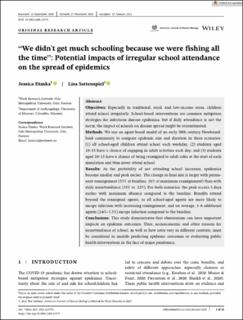| dc.contributor.author | Dimka, Jessica | |
| dc.contributor.author | Sattenspiel, Lisa | |
| dc.date.accessioned | 2021-06-11T11:37:22Z | |
| dc.date.available | 2021-06-11T11:37:22Z | |
| dc.date.created | 2021-02-18T14:05:21Z | |
| dc.date.issued | 2021-02-17 | |
| dc.identifier.citation | American Journal of Human Biology. 2021 | en_US |
| dc.identifier.issn | 1042-0533 | |
| dc.identifier.uri | https://hdl.handle.net/11250/2758975 | |
| dc.description.abstract | Objectives: Especially in traditional, rural, and low-income areas, children attend school irregularly. School-based interventions are common mitigation strategies for infectious disease epidemics, but if daily attendance is not the norm, the impact of schools on disease spread might be overestimated. Methods: We use an agent-based model of an early 20th century Newfound- land community to compare epidemic size and duration in three scenarios: (1) all school-aged children attend school each weekday, (2) students aged 10–15 have a chance of engaging in adult activities each day, and (3) students aged 10–15 have a chance of being reassigned to adult roles at the start of each simulation and thus never attend school.
Results: As the probability of not attending school increases, epidemics become smaller and peak earlier. The change in final size is larger with perma- nent reassignment (35% at baseline, 18% at maximum reassignment) than with daily nonattendance (35% vs. 22%). For both scenarios, the peak occurs 3 days earlier with maximum absence compared to the baseline. Benefits extend beyond the reassigned agents, as all school-aged agents are more likely to escape infection with increasing reassignment, and on average, 3–6 additional agents (2.6%–5.3%) escape infection compared to the baseline.
Conclusions: This study demonstrates that absenteeism can have important impacts on epidemic outcomes. Thus, socioeconomic and other reasons for nonattendance of school, as well as how rates vary in different contexts, must be considered in models predicting epidemic outcomes or evaluating public health interventions in the face of major pandemics. | en_US |
| dc.language.iso | eng | en_US |
| dc.publisher | Wiley | en_US |
| dc.relation.ispartofseries | American Journal of Human Biology; | |
| dc.rights | Navngivelse 4.0 Internasjonal | * |
| dc.rights.uri | http://creativecommons.org/licenses/by/4.0/deed.no | * |
| dc.subject | Attending schools | en_US |
| dc.subject | Epidemics spreads | en_US |
| dc.subject | Epidemic outcomes | en_US |
| dc.title | “We didn't get much schooling because we were fishing all the time”: Potential impacts of irregular school attendance on the spread of epidemics | en_US |
| dc.type | Peer reviewed | en_US |
| dc.type | Journal article | en_US |
| dc.description.version | publishedVersion | en_US |
| dc.rights.holder | © 2021 The Authors. | en_US |
| dc.source.articlenumber | e23578 | en_US |
| cristin.ispublished | true | |
| cristin.fulltext | original | |
| cristin.qualitycode | 1 | |
| dc.identifier.doi | https://doi.org/10.1002/ajhb.23578 | |
| dc.identifier.cristin | 1891394 | |
| dc.source.journal | American Journal of Human Biology | en_US |

